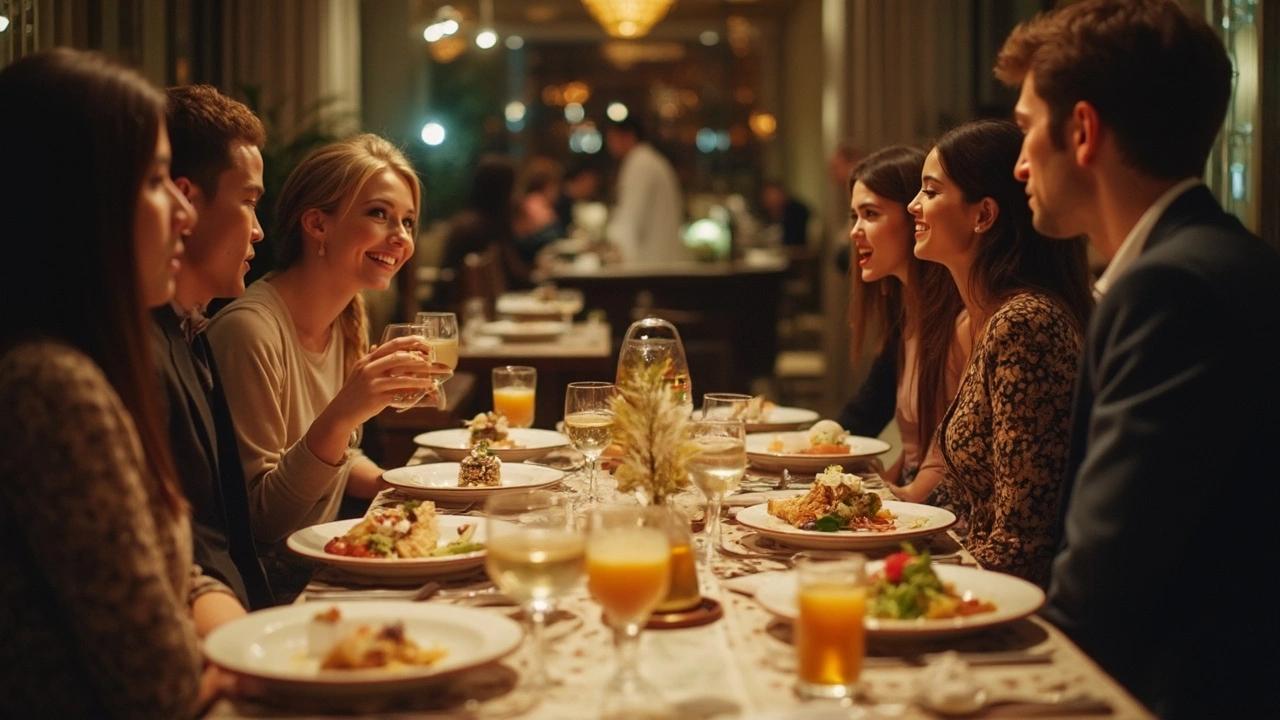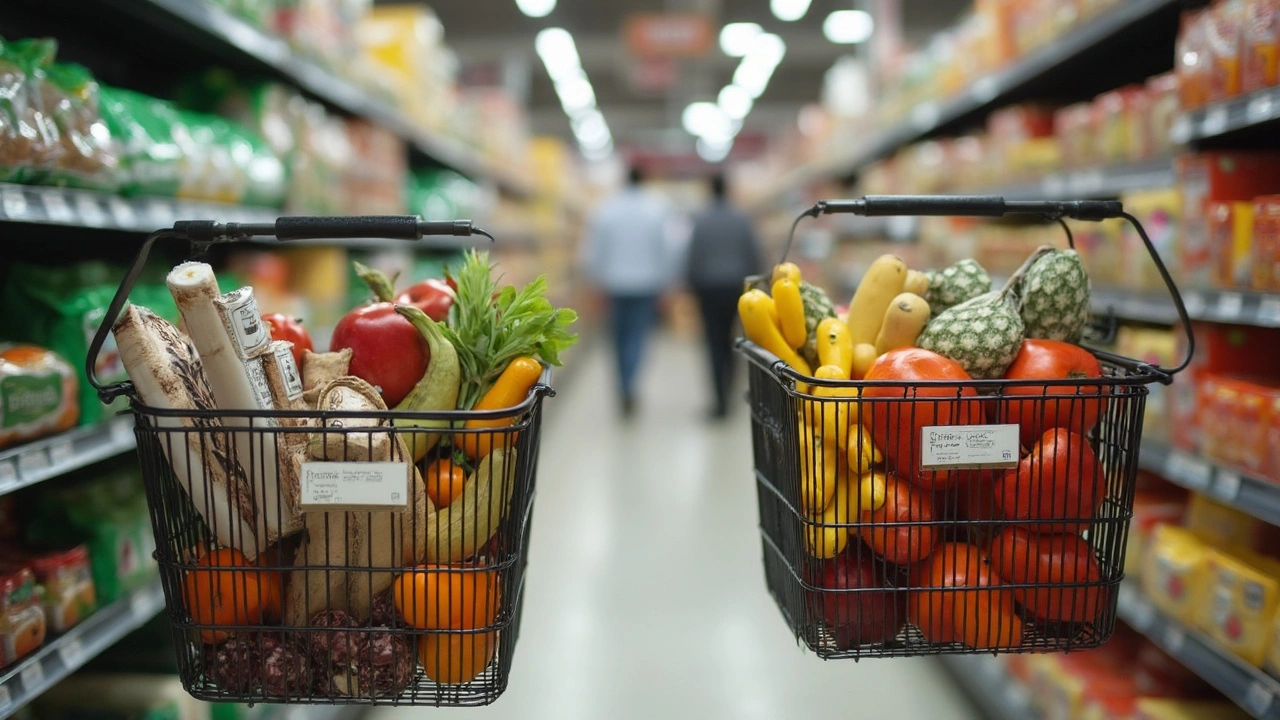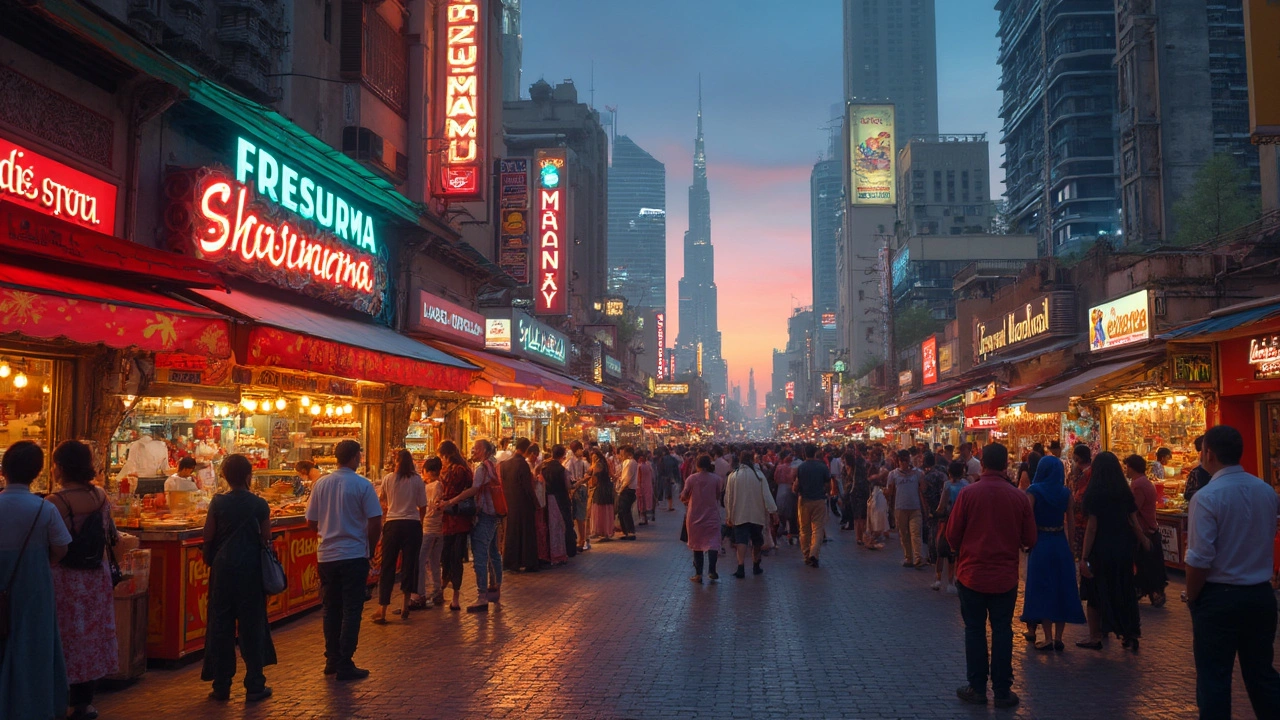The prices for food in Dubai can be pretty surprising, and honestly, it's not always what first-timers expect. Sure, those photos of gold-dusted burgers and seven-star buffets look amazing (and cost a small fortune), but if you stick to everyday spots, you don’t have to spend a load just to eat well. Dubai is packed with options for every budget—think $3 shawarma on a street corner or a $250 dinner-with-a-view at Burj Khalifa.
The secret? Locals and regulars know where to look and what to avoid. You can pay way too much if you fall into the tourist traps, or you can eat like a pro by scanning menus, asking around, and skipping the glitzy areas. Even grocery shopping can get confusing—some supermarkets are wallet-friendly, while others have crazy markup on imported stuff. If you’re planning to spend more than a couple days here, it pays to learn the tricks that help residents eat well without going broke.
- Street Eats and Cheap Bites
- Eating Out: Cafes to Fine Dining
- Grocery Shopping in Dubai
- Hidden Charges and Tourist Traps
- Money-Saving Tips for Everyday Meals
Street Eats and Cheap Bites
Don’t let Dubai’s flashy skyline fool you—some of the best food deals hide in plain sight, right on city streets and in tiny shops. The real MVPs for anyone watching their wallet are shawarma joints, Pakistani and Indian cafeterias, and classic baklava bakeries. These spots aren’t the kind you’ll find in glitzy malls. Instead, you’ll spot plastic chairs, queues of taxi drivers, and menus with more flavor than price tags.
Take shawarma: you can get a stuffed-to-bursting pita at places like Al Mallah or Automatic for around AED 10 ($2.75). A hot samosa might cost just AED 2 (food prices Dubai can be surprisingly low if you know where to look). Pakistani biryani lunches often run AED 15–20. And there’s something about Karak chai (spiced tea) for AED 1.50 that feels like a mini win every time.
- Bastakiya and Karama neighborhoods: These areas are scattered with low-priced curries, fresh naan, and grilled meats. Locals swear by Ravi Restaurant in Satwa and Karachi Darbar in Deira for their reliable, tasty dishes.
- Al Rigga or Al Fahidi metros: Step out and you’ll run into Lebanese bakeries selling manakish (think Middle Eastern cheesy pizza) for around AED 8.
- Food courts in older malls: Places like BurJuman or Al Ghurair are filled with gems offering big portions for AED 20 or less.
Here’s a quick rundown of what a typical cheap meal might cost in Dubai’s budget food scene:
| Item | Average Price (AED) | Approx. USD |
|---|---|---|
| Shawarma Sandwich | 10 | 2.75 |
| Karak Chai | 1.5 | 0.40 |
| Biryani | 18 | 5 |
| Manakish | 8 | 2 |
| Samosa (each) | 2 | 0.55 |
The trick: steer clear of tourist-heavy areas and fancy hotels if you want to eat cheap. A simple walk into any neighborhood packed with expat workers almost guarantees affordable, tasty food. It’s easy to fill up for under AED 20—just keep your eyes open for long lines and busy kitchens. That’s where you’ll usually find the best deals.
Eating Out: Cafes to Fine Dining
If you're confused about how much you'll spend on eating out in Dubai, trust me, you're not alone. The city has such a wide range that it’s easy to lose track of what’s normal. You can grab a sandwich and coffee at a local cafe for under 40 AED ($11), or you can sit down for a fancy steak in Downtown and watch your bill go north of 500 AED ($136)—just for yourself!
In terms of cafes, the trendier spots in places like Jumeirah or Marina usually charge 40–75 AED ($11–$20) for a main course and about 20–30 AED ($5–$8) for a coffee or fresh juice. There are chains like PAUL and Caribou Coffee everywhere, offering similar prices to what you’d pay in big European or North American cities.
When it comes to restaurants, malls are your friend for mid-range prices. Think about 75–150 AED ($20–$40) for a decent meal with a drink at places like PF Chang’s or Shake Shack. Don’t ignore the small Indian and Iranian restaurants—they’ll fill you up for 25–40 AED ($7–$11) thanks to the huge South Asian population here, and the food’s both authentic and cheap.
For the "Dubai bucket list" luxury dinners (Nobu, Zuma, or any restaurant inside a tower with shocking views), expect 350–700 AED ($95–$190) per person, not including drinks. Alcohol can double your bill, partly because of high taxes. Some venues add a 10% service charge and city tax on top, which people often miss on the menu.
Here’s how average meal costs stack up:
| Type | Average Price (AED) | USD Equivalent |
|---|---|---|
| Local Cafe (Main + Drink) | 40–75 | $11–$20 |
| Mid-Range Mall Restaurant | 75–150 | $20–$40 |
| Budget Restaurant (Indian, Iranian) | 25–40 | $7–$11 |
| High-End Dining | 350–700 | $95–$190 |
Dubai’s food prices shift a lot depending on the location. Places near tourist attractions or famous hotels will always cost more. If you want to save, avoid restaurants inside hotels—especially if you don't plan to drink. Plus, the city comes alive with brunches on Fridays and Saturdays, which sound cheap at first (a lot of places advertise “unlimited” offers for 220–450 AED), but with add-ons, it never stays that way.
- Consider dining outside the main tourist hubs like Downtown, Marina, or Palm Jumeirah for better deals.
- If you’re out late, delivery apps like Talabat and Zomato sometimes drop prices after 11pm—perfect when you’re hungry after a night out.
- Lunchtime deals are huge here: tons of places offer set menus for much less than dinner prices.
Bottom line, you don’t need to be rich to eat well in Dubai. You just have to know the right spots and stay awake to the hidden extras that can sneak onto your final bill.

Grocery Shopping in Dubai
Heading out for groceries in Dubai is a whole different game compared to eating out. The city is full of supermarkets, hypermarkets, and little convenience shops. You’ve got big chains like Carrefour, Lulu, Spinneys, and Waitrose. Carrefour and Lulu are the go-tos if you want better deals and plenty of choices. Spinney’s and Waitrose are fancier and pricier, with lots of imported items (sometimes twice the price you’d pay at home).
The big thing to know: imported stuff costs way more. If you’re a fan of European cheese or American snacks, brace yourself for sticker shock. A tiny box of imported cereal can run you $7 (yes, for real), and a pint of Ben & Jerry’s might hit $10. Local brands, fresh produce, rice, and spices are way easier on your wallet. You can grab a kilo of local tomatoes for about $1.50, and bread from a bakery counter is about $1.
Fresh meat isn’t cheap, especially if you go for premium steaks or foreign chicken. But regular chicken (from UAE or Saudi suppliers) lands around $3 to $4 a kilo. Eggs, milk, and basic groceries stack up, but local brands always cost less than imports. If you shop with an eye on labels, you’ll save a lot over time.
- Shop at Carrefour or Lulu for cheapest regular prices and good (sometimes crazy) promotions.
- Watch for “Sunday offers” or discount bins on produce—it’s a smart way to cut costs.
- Some neighborhoods have small, old-school markets or South Asian grocers. Their food prices in Dubai are often lower than in high-end chains, and bargaining for produce isn’t unheard of.
- Bulk-buying rice, spices, and pulses saves loads in the long run. Supermarkets and specialty spice shops in Deira or Karama neighborhoods are famous for deals.
Delivery apps like Instashop or Noon Grocery have taken off, but for rare or premium items, you’ll pay more plus a delivery fee. Still, they’re handy if you’re stuck at home or working late. All in, groceries aren’t cheap if you shop like a tourist, but it’s possible to eat well for less—just skip big-name imports and embrace local brands.
Hidden Charges and Tourist Traps
Eating out in Dubai can turn pricey fast, but not always for the reasons you think. The menus may look fine at first glance, but there are a bunch of sneaky charges waiting to surprise you at the end of your meal. Let’s start with the most common one—service charges. Most restaurants (especially those in hotels and tourist areas) slap an extra 10-12% onto your bill as a service or hospitality charge. Then Dubai taxes your final bill with a municipal tax, usually 7%, and if you're eating in a hotel, add another 5% VAT. These can stack up—what looked like a 100 AED lunch quickly jumps to 120 AED or more without you noticing.
Some places even charge for water (yep, tap water isn’t the norm here; you'll pay for bottled), extra bread, or dips that just show up on the table. Always check if these costs are listed before you say yes. Also, keep an eye on touristy restaurants in Downtown, Dubai Marina, and Palm Jumeirah—those Instagram-friendly spots come with marked-up prices, fancy presentation, and the highest hidden fees.
Here's a quick look at typical add-ons you’ll spot on your receipt:
- Service charge: 10-12% (automatic, not always distributed to staff)
- Municipal tax: 7%
- VAT: 5%
- Bottled water and extras: 8-20 AED each
- Cover charge at some restaurants: 10-25 AED per person
To make it clearer, check out this table for a breakdown of an average restaurant bill at a mid-range hotel restaurant:
| Item | Price (AED) |
|---|---|
| Main Course | 80 |
| Bottled Water | 10 |
| Soft Drink | 15 |
| Service Charge (10%) | 10.5 |
| Municipal Tax (7%) | 7.4 |
| VAT (5%) | 5.2 |
| Total | 128.1 |
If you’re after a normal meal and don’t feel like dropping a fortune, steer clear of restaurants inside big hotels and flashy malls. Go where the locals go—Old Dubai, Karama, Al Rigga, or Deira. You’ll skip hefty add-ons and actually get authentic bites.
One last tip: watch for the fancy cocktails or imported foods. Alcohol is never cheap here due to taxes, and a single drink can add 40-70 AED to your bill. Quick math: that’s sometimes more than the meal itself. So, when it comes to food prices Dubai newbies can get caught out, but with an eye for the fine print and a little street smarts, you can keep your budget in check.

Money-Saving Tips for Everyday Meals
Eating well in Dubai without draining your wallet is all about smart choices. Locals save a chunk by knowing which foods are actually cheap and where to skip the big chains. Here’s how you can do the same and keep your daily costs in check, whether you’re here for work, play, or just passing through:
- Choose local eateries: Skip the fancy hotel restaurants if you want the real deals. Pakistani, Indian, and Arabic cafeterias (often called “cafe” or “restaurant” in simple signs) dish up filling meals starting from AED 10–20. These places are all over neighborhoods like Deira, Bur Dubai, and Karama.
- Lunch specials are your friend: Many regular restaurants and even some buffets offer weekday lunch menus for as low as AED 25–40. Look out for these, especially in malls or business districts. You might get a hearty portion for way less than at dinner time.
- Supermarket hot counters: Most supermarkets (like Carrefour, Lulu, Union Coop) have cooked food sections. A full meal—like grilled chicken, biryani, or a mixed plate with rice—often costs less than AED 20–25. These are aimed at workers and local families, so prices are always fair.
- Skip imported snacks: Price tags spike for anything imported, especially cheese, chocolates, and packaged stuff. Local brands or foods made in the region are way cheaper and taste just as good. Dates, laban, and fresh bread cost only a few dirhams each.
- Water hack: Always order regular bottled water (‘small water’) instead of imported brands in restaurants. Some places quietly swap in the pricey ones, so be clear. Or just fill a reusable bottle from your hotel or flat instead of buying outside.
| Item | Cheap Eats | Tourist Spots |
|---|---|---|
| Shawarma | AED 5–8 | AED 25–35 |
| Mixed Grill Meal | AED 25–35 | AED 80–120 |
| Bottle of Water | AED 1.5–3 | AED 10–25 |
| Supermarket Hot Plate | AED 12–25 | – |
| Coffee | AED 6–12 | AED 22–38 |
If you want to really stretch your dirhams, try meal-prepping simple stuff at home. Eggs, flatbreads, salad veggies, and hummus together make a good dinner for under AED 10. Apps like Zomato or Careem Eats sometimes offer hidden discounts, especially for new users or during slower meal times. And if you’re out late, food courts in bigger malls drop prices right before closing—think half-price bakery pastries and leftover curries. It’s a lifesaver if you’re working odd hours or just got back late from a client meeting.
Bottom line? There are dozens of ways to cut the food prices Dubai reputation down to size if you’re willing to explore like a local.
